
What matters most about #TheDress isn't the color scheme. It's the popularity of the story.
BuzzFeed's now-famous Thursday story -- simply titled "What Colors Are The Dress?" -- now looks like it'll become the sprawling web site's most-viewed post ever.
"We've had other huge hits," BuzzFeed editor in chief Ben Smith said. But this one "went bigger faster."
Maybe that's the lesson for BuzzFeed and its many rivals: The speed with which #TheDress happened. Stories that previously would have "gone viral" over a period of days can now achieve the same success in hours.
Smith credits the proliferation of mobile devices and the ever-increasing "universality" of the Internet.
"The network is so much more fully built out than it was even a year or two ago," he said.
To his point, 79% of Thursday's views of "What Colors Are The Dress?" (which was basically an optical illusion) came from mobile devices like iPhones. The huge proportion of mobile viewership underscores why technology companies -- and, more recently, media companies -- have been talking about being "mobile-first."
When Smith was on CNN's "Reliable Sources" on Sunday, and I commented about the mobile-focused future, he said "It's the present, not the future."
"Certainly," he said, "the way we think about our readers is a person holding a phone."
Watch: Ben Smith on "Reliable Sources"
According to BuzzFeed, 94% of the story's views came from social media sites like Twitter and "dark social" sources like links swapped via text-message.
Smith said he appreciated how people also shared the photo of the dress physically, by passing their phones and tablets to friends and family (and instigating the fights that BuzzFeed subsequently wrote about).
"Is that the Internet or I-R-L?" he asked me before Sunday's show, using the abbreviation for "in real life."
Dao Nguyen, BuzzFeed's publisher, wrote about the same dynamic in a Friday blog post.
The story "shaped conversations at dinner, in bars, on couches, over text, all driven by mobile and the ability to show your phone to your friend," Nguyen wrote. "Same picture, same device, but different colors! In less than 24 hours, people from every corner of the world were looking at each other's phones at a post, on a site, run by a company totally optimized for social and mobile."
It helped that BuzzFeed published the original story in the 6 p.m. hour on the East Coast, just in time for mobile phone prime time. Viewership surged in the 8, 9 and 10 p.m. hours.
And BuzzFeed -- not to mention lots of other web sites that raced to follow up -- simultaneously responded to interest and stoked interest by publishing a dozen other stories about #TheDress debate.
"We definitely have a culture of -- when something's blowing up -- swarming it," Smith said.
Now, three days later, 11 of the top-viewed 20 posts on BuzzFeed (ranked by weekly traffic) are related to the dress.
The original story has 37.6 million views. A followup, "This Might Explain Why That Dress Looks Blue And Black, And White And Gold," has 12.2 million.
BuzzFeed's most-viewed story ever is a quiz called "What State Do You Actually Live In?" It was posted in February 2014, and it has racked up 41.6 million views. #TheDress is already in striking distance.


